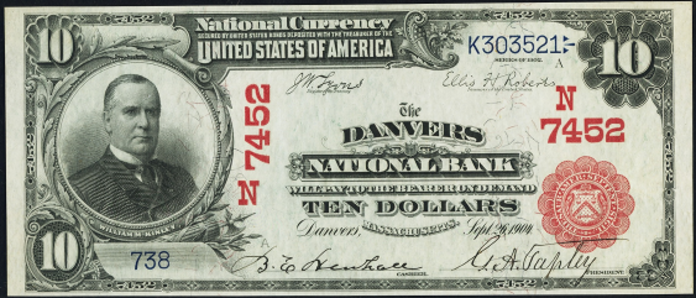Ten Dollar Notes › Nationals › 1902 Ten Dollar National Bank Notes › Indiana Charters › 1902 $10 Remington Indiana Farmers National Bank
Get Value Now
| Item | Info |
|---|---|
| Series | 1902 |
| Charter | #11355 Farmers National Bank of Remington, Indiana |
| Year Chartered | 1919, 288 Banks Chartered |
| City Info | Remington is a town in Carpenter Township, Jasper County, Indiana, United States. The population was 1,185 at the 2010 census. Remington was first laid out in 1860 by Jesse H. Fordice. It was originally called Carpenter Station, after Carpenter's Creek where a railroad station had been established, around which the town grew. The name was later changed to Remington, after the founder of the general store. The main trade was in grain, as the area consisted of excellent prairie farmland; the town's position on the Pittsburgh, Chicago and St. Louis Railroad made it a good location for such trade. The first grain elevator was built in 1870 by Church and Hartley; the second was built by the Hathaway Brothers in 1872; and in 1879, James Irvin built a third. In 1883 the population was about 900. Source: Wikipedia |
| Similar Cities | If your note doesn't match try: 1. Remington, Indiana - First National Bank |
| Seal Varieties | Red, Blue |
| See Also | If your note doesn't match try: 1. 1907 $10 Gold Certificate 2. 1901 $10 Legal Tender 3. 1908 $10 Silver Certificates |
| Other Info | 1. Value depends on notes known for charter, condition and market demand. |
| Neat Fact | Check your note's serial number. Serial #1 notes are valuable, even on common charters. Serial numbers 2-4 are also desirable in some cases. |
No Obligations Offers and Appraisals
Please submit a good photo or scan. It will be identified and evaluated. Understand there may be subtle differences between the image you see above and your note. Signatures, design, markings and note condition will determine the offer price. Notes in Uncirculated or better condition receive the best offers.
Appraisals can be estimated for wholesale and retail prices. Wholesale is what dealers typically pay. Retail is what a collector might pay. Retail is slightly higher in most cases.
Please visit this page for USA Paper Money Reference. Do not treat this page as a reference guide, it is for appraisal and acquisition purposes only.
